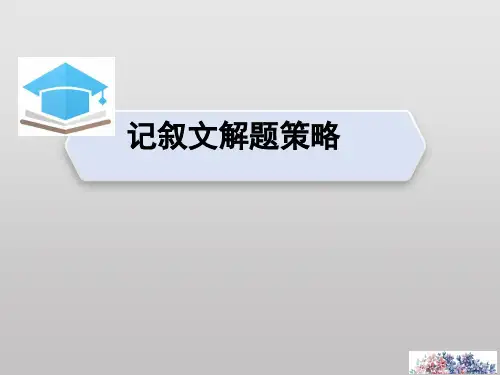高三英语二轮复习阅读理解公开课教学教材
- 格式:ppt
- 大小:1.03 MB
- 文档页数:28
![[优选]阅读理解高考英语二轮复习演示课件](https://uimg.taocdn.com/c6dbdb389b89680202d82524.webp)
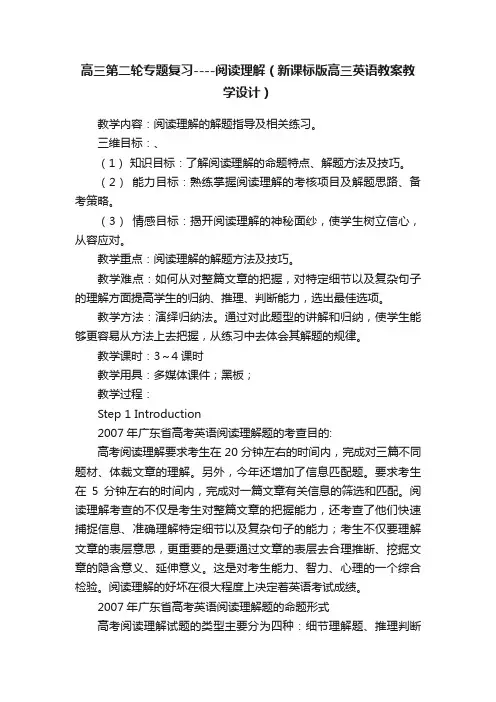
高三第二轮专题复习----阅读理解(新课标版高三英语教案教学设计)教学内容:阅读理解的解题指导及相关练习。
三维目标:、(1)知识目标:了解阅读理解的命题特点、解题方法及技巧。
(2)能力目标:熟练掌握阅读理解的考核项目及解题思路、备考策略。
(3)情感目标:揭开阅读理解的神秘面纱,使学生树立信心,从容应对。
教学重点:阅读理解的解题方法及技巧。
教学难点:如何从对整篇文章的把握,对特定细节以及复杂句子的理解方面提高学生的归纳、推理、判断能力,选出最佳选项。
教学方法:演绎归纳法。
通过对此题型的讲解和归纳,使学生能够更容易从方法上去把握,从练习中去体会其解题的规律。
教学课时:3~4课时教学用具:多媒体课件;黑板;教学过程:Step 1 Introduction2007年广东省高考英语阅读理解题的考查目的:高考阅读理解要求考生在20分钟左右的时间内,完成对三篇不同题材、体裁文章的理解。
另外,今年还增加了信息匹配题。
要求考生在5分钟左右的时间内,完成对一篇文章有关信息的筛选和匹配。
阅读理解考查的不仅是考生对整篇文章的把握能力,还考查了他们快速捕捉信息、准确理解特定细节以及复杂句子的能力;考生不仅要理解文章的表层意思,更重要的是要通过文章的表层去合理推断、挖掘文章的隐含意义、延伸意义。
这是对考生能力、智力、心理的一个综合检验。
阅读理解的好坏在很大程度上决定着英语考试成绩。
2007年广东省高考英语阅读理解题的命题形式高考阅读理解试题的类型主要分为四种:细节理解题、推理判断题、猜测词义题和主旨大意题。
它们常见的提问形式如下:(1)细节理解题常见的提问形式Which of the following (statements) is TRUE/not TRUE?According to the passage, who(what, where ,when, why, how, etc,)…?The following are mentioned EXCEPT______?Why does the author say…?Where in the passage does the author describe…?(2) 推理判断题常见的提问形式The writer implies that______It can be inferred from the passage that______It suggests that_______It can be included from the passage that_____We can draw a conclusion that_____We can learn from the passage that____(3)猜测词义题常见的提问形式The un derlined word “hit”( in paragraph 1) probably means___What does the underlined part“reimburse you” probably mean?By saying “it is all worth it” in the last paragraph ,the author means that ______(4)主旨大意题常见的提问形式What is the main idea of the passage?The best title for the passage might be____The main purpose of the passage is to _____The passage mainly tells us /is mainly about___Step 2 Main content**阅读理解解题技巧我们结合《英语周报》高三广州专版第30,31期的专题复习内容研以及配套的例题分析(见《英语周报》),针对高考阅读理解的四种主要题型,给学生做解题策略指导和技巧总结.1.如何快速、准确地捕捉信息词句,做好细节理解题策略指导:先浏览一遍题目,把题目的要求储存在大脑中,带着疑问去快速阅读,然后找出与题目相关的信息词句加以理解分析,去伪存真。
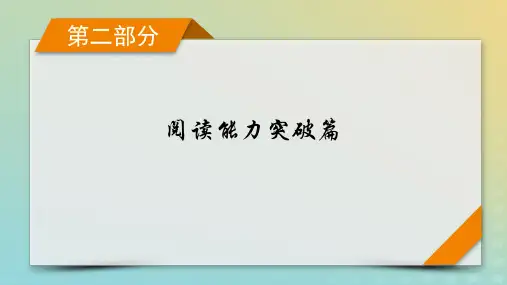
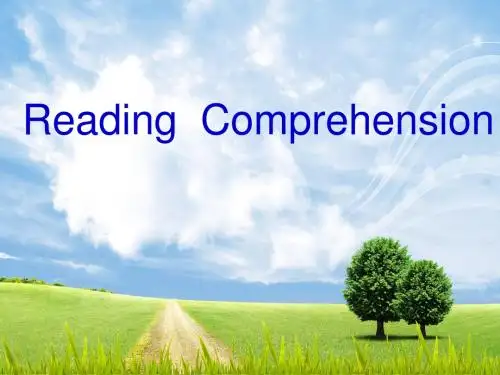
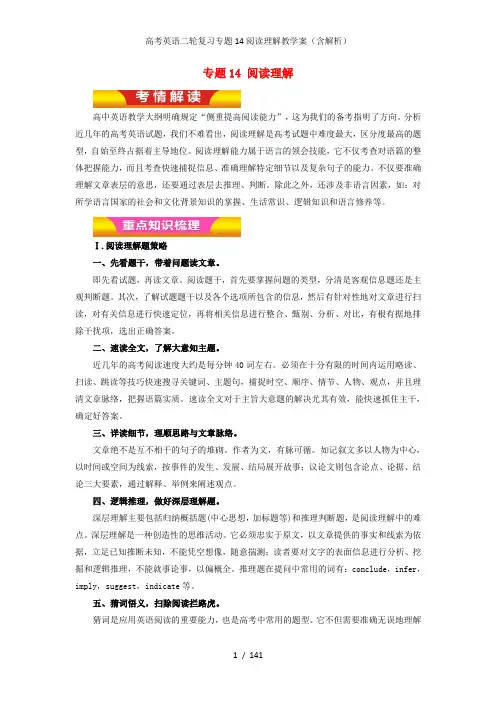
专题14 阅读理解高中英语教学大纲明确规定“侧重提高阅读能力”,这为我们的备考指明了方向。
分析近几年的高考英语试题,我们不难看出,阅读理解是高考试题中难度最大,区分度最高的题型,自始至终占据着主导地位。
阅读理解能力属于语言的领会技能,它不仅考查对语篇的整体把握能力,而且考查快速捕捉信息、准确理解特定细节以及复杂句子的能力。
不仅要准确理解文章表层的意思,还要通过表层去推理、判断。
除此之外,还涉及非语言因素,如:对所学语言国家的社会和文化背景知识的掌握、生活常识、逻辑知识和语言修养等。
Ⅰ.阅读理解题策略一、先看题干,带着问题读文章。
即先看试题,再读文章。
阅读题干,首先要掌握问题的类型,分清是客观信息题还是主观判断题。
其次,了解试题题干以及各个选项所包含的信息,然后有针对性地对文章进行扫读,对有关信息进行快速定位,再将相关信息进行整合、甄别、分析、对比,有根有据地排除干扰项,选出正确答案。
二、速读全文,了解大意知主题。
近几年的高考阅读速度大约是每分钟40词左右。
必须在十分有限的时间内运用略读、扫读、跳读等技巧快速搜寻关键词、主题句,捕捉时空、顺序、情节、人物、观点,并且理清文章脉络,把握语篇实质。
速读全文对于主旨大意题的解决尤其有效,能快速抓住主干,确定好答案。
三、详读细节,理顺思路与文章脉络。
文章绝不是互不相干的句子的堆砌。
作者为文,有脉可循。
如记叙文多以人物为中心,以时间或空间为线索,按事件的发生、发展、结局展开故事;议论文则包含论点、论据、结论三大要素,通过解释、举例来阐述观点。
四、逻辑推理,做好深层理解题。
深层理解主要包括归纳概括题(中心思想,加标题等)和推理判断题,是阅读理解中的难点。
深层理解是一种创造性的思维活动。
它必须忠实于原文,以文章提供的事实和线索为依据,立足已知推断未知,不能凭空想像,随意揣测;读者要对文字的表面信息进行分析、挖掘和逻辑推理,不能就事论事,以偏概全。
推理题在提问中常用的词有:conclude,infer,imply,suggest,indicate等。
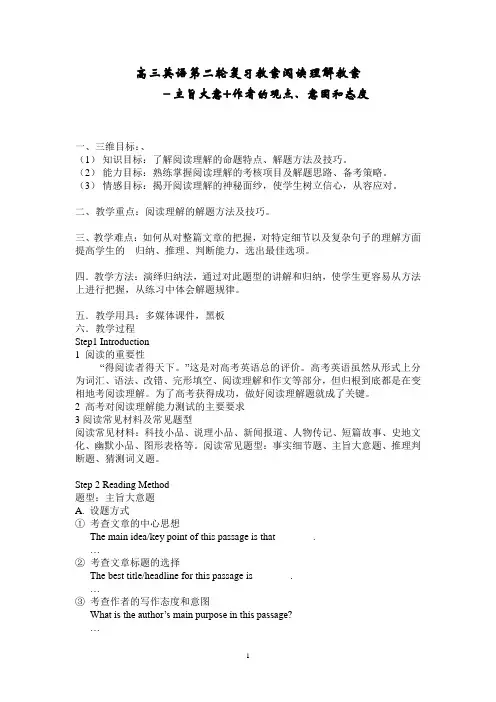
高三英语第二轮复习教案阅读理解教案-主旨大意+作者的观点、意图和态度一、三维目标:、(1)知识目标:了解阅读理解的命题特点、解题方法及技巧。
(2)能力目标:熟练掌握阅读理解的考核项目及解题思路、备考策略。
(3)情感目标:揭开阅读理解的神秘面纱,使学生树立信心,从容应对。
二、教学重点:阅读理解的解题方法及技巧。
三、教学难点:如何从对整篇文章的把握,对特定细节以及复杂句子的理解方面提高学生的归纳、推理、判断能力,选出最佳选项。
四.教学方法:演绎归纳法,通过对此题型的讲解和归纳,使学生更容易从方法上进行把握,从练习中体会解题规律。
五.教学用具:多媒体课件,黑板六.教学过程Step1 Introduction1 阅读的重要性“得阅读者得天下。
”这是对高考英语总的评价。
高考英语虽然从形式上分为词汇、语法、改错、完形填空、阅读理解和作文等部分,但归根到底都是在变相地考阅读理解。
为了高考获得成功,做好阅读理解题就成了关键。
2 高考对阅读理解能力测试的主要要求3阅读常见材料及常见题型阅读常见材料:科技小品、说理小品、新闻报道、人物传记、短篇故事、史地文化、幽默小品、图形表格等。
阅读常见题型:事实细节题、主旨大意题、推理判断题、猜测词义题。
Step 2 Reading Method题型:主旨大意题A. 设题方式①考查文章的中心思想The main idea/key point of this passage is that _______.…②考查文章标题的选择The best title/headline for this passage is _______.…③考查作者的写作态度和意图What is the author’s main purpose in this passage?…B. 干扰项特点①以偏概全。
干扰项只阐述了文章的一部分内容,也就是文章的局部信息。
②断章取义。
干扰项常常以文章中的个别信息或个别字眼作为选项的设置内容,或者以次要的事实或细节冒充全文的主要观点。
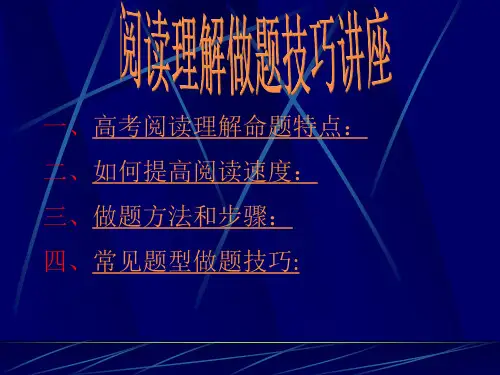
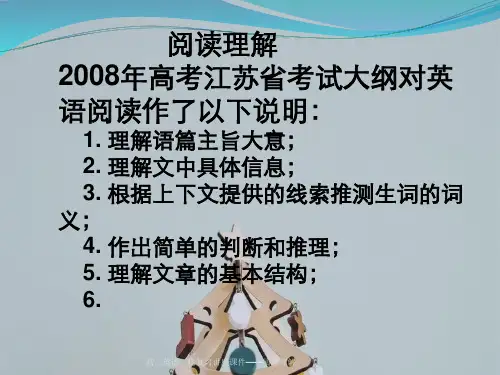
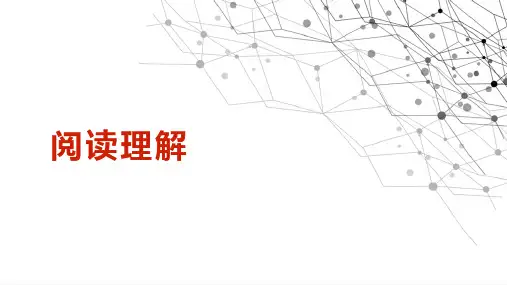
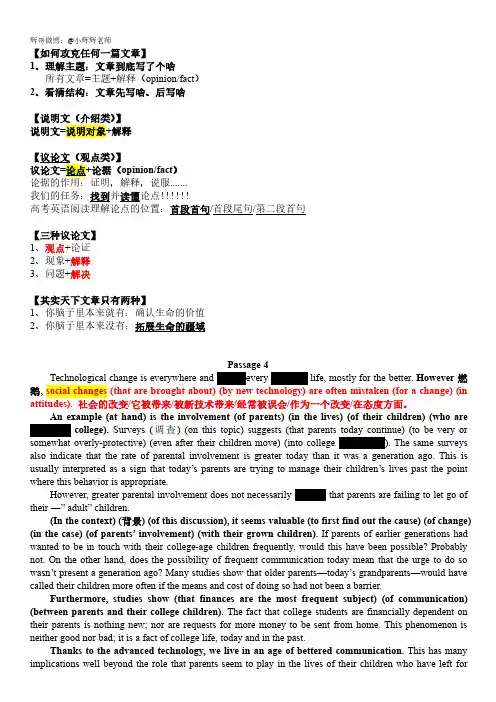
【如何攻克任何一篇文章】1、理解主题:文章到底写了个啥所有文章=主题+解释(opinion/fact)2、看清结构:文章先写啥、后写啥【说明文(介绍类)】说明文=说明对象+解释】论据(opinion/fact).......我们的任务:找到并读懂论点!!!!!!高考英语阅读理解论点的位置:首段首句/首段尾句/第二段首句【三种议论文】1、观点+论证2、现象+解释3、问题+解决【其实天下文章只有两种】1、你脑子里本来就有:确认生命的价值2、你脑子里本来没有:拓展生命的疆域Passage4Technological change is everywhere and affects every aspect of life,mostly for the better.However燃鹅,social changes(that are brought about)(by new technology)are often mistaken(for a change)(in attitudes).社会的改变/它被带来/被新技术带来/经常被误会/作为一个改变/在态度方面。
An example(at hand)is the involvement(of parents)(in the lives)(of their children)(who are attending college).Surveys(调查)(on this topic)suggests(that parents today continue)(to be very or overly-protective)(even after their children move)(into college dormitories).The same surveys also indicate that the rate of parental involvement is greater today than it was a generation ago.This is usually interpreted as a sign that today’s parents are trying to manage their children’s lives past the point where this behavior is appropriate.However,greater parental involvement does not necessarily indicate that parents are failing to let go of their―”adult”children.(In the context)(背景)(of this discussion),it seems valuable(to first find out the cause)(of change) (in the case)(of parents’involvement)(with their grown children).If parents of earlier generations had wanted to be in touch with their college-age children frequently,would this have been possible?Probably not.On the other hand,does the possibility of frequent communication today mean that the urge to do so wasn’t present a generation ago?Many studies show that older parents—today’s grandparents—would have called their children more often if the means and cost of doing so had not been a barrier.Furthermore,studies show(that finances are the most frequent subject)(of communication) (between parents and their college children).The fact that college students are financially dependent on their parents is nothing new;nor are requests for more money to be sent from home.This phenomenon is neither good nor bad;it is a fact of college life,today and in the past.Thanks to the advanced technology,we live in an age of bettered communication.This has many implications well beyond the role that parents seem to play in the lives of their children who have left forcollege.But it is useful to bear in mind that all such changes come from the technology and not some imagined desire by parents to keep their children under their wings.67.The surveys inform us of______.A.the development of technologyB.the changes of adult children’s behaviorC.the parents’over-protection of their college childrenD.the means and expenses of students’communication68.The writer believes that______.A.parents today are more protective than those in the pastB.the disadvantages of new technology outweigh its advantagesC.technology explains greater parental involvement with their childrenD.parents’changed attitudes lead to college children’s delayed independence69.What is the best title for the passage?A.Technology or AttitudeB.Dependence or IndependenceC.Family Influence or Social ChangesD.College Management or Communication Advancement70.Which of the following shows the development of ideas in this passage?【文章结构题如何做?】(1(2Passage6B(In the United States alone),over100million cell-phones are thrown away(each year). T Cell-phones are part(of a growing mountain)(of electronic waste)(like computers and personal digital assistants).E The electronic waste stream is increasing three times faster(than traditional garbage)(as a whole).Electronic devices contain valuable metals such as gold and silver.A Swiss study reported that while the weight of electronic goods represented by precious metals was relatively small in comparison to total waste,the concentration(含量)of gold and other precious metals was higher in so-called e-waste than in naturally occurring minerals.Electronic wastes also contain many poisonous metals.Even when the machines are recycled and the harmful metals removed,the recycling process often is carried out in poor countries,in practically uncontrolled ways which allow many poisonous substances to escape into the environment.Creating products(out of raw materials)creates much more waste material,up to100times more, than the material contained in the finished products.Consider again the cell-phone,and imagine the mines that produced those metals,the factories needed to make the box and packaging(包装)it came in.Many wastes produced in the producing process are harmful as well.The U.S.Environmental Protection Agency notes that most waste is dangerous in that“theproduction,distribution,and use of products—as well as management of the resulting waste—all result in greenhouse gas release.Individuals can reduce their contribution by creating less waste at the start—for instance,buying reusable products and recycling.In many countries the concept(of extended producer responsibility)is being considered or has been put(in place)(as an incentive)(动机)(for reducing waste).If producers are required to take back packaging they use to sell their products,would they reduce the packaging in the first place?Governments’incentive(to require producers)(to take responsibility)(for the packaging)(they produce)is usually based(on money).Why,they ask,should cities or towns be responsible for paying to deal with the bubble wrap(气泡垫)that encased your television?(From the governments’point of view),a primary goal(of laws)(requiring extended producer responsibility)is(to transfer both the costs and the physical responsibility)(of waste management)(from the government and tax-payers)(back to the producers).58.By mentioning the Swiss study,the author intends to tell us that______.A.the weight of e-goods is rather smallB.e-waste deserves to be made good use ofC.natural minerals contain more precious metalsD.the percentage of precious metals is heavy in e-waste59.The responsibility of e-waste treatment should be extended______.A.from producers to governmentsB.from governments to producersC.from individuals to distributorsD.from distributors to governments60.What does the passage mainly talk about?A.The increase in e-waste.B.The creation of e-waste.C.The seriousness of e-wasteD.The management of e-waste.。
